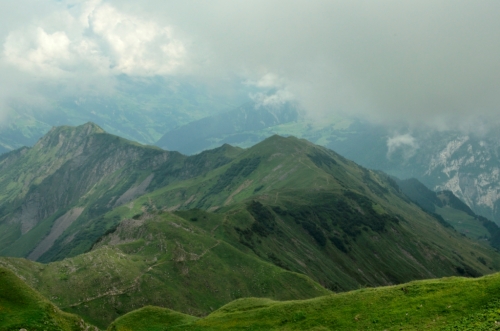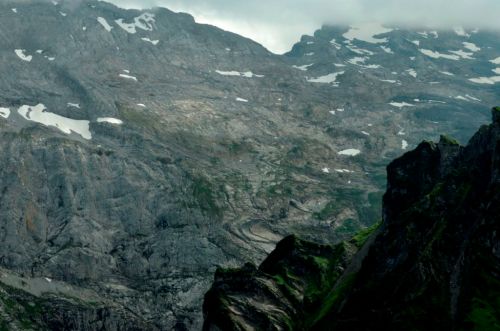So often it is the superlatives, the oldest, the biggest, the first that make it into the media. That is what happened with the site of Attinghausen-Geissrüggen in the Canton Uri, “the oldest Alp Hut in Switzerland”, or at least Central Switzerland. (See hyperlinks in the text.) Regular visitors to Hazelnut Relations will know that in 2010 I was involved in compiling the archaeological site inventory of the Canton Uri and during that same summer was part of the team surveying and excavating the area between Andermatt and Hospental ahead of the building of a golf course. Some weeks ago now, I helped some colleagues dig an alpine site in Canton Uri for a few days. And I actually got to wield my mighty trowel! Even though I thought I would not really get to dig at all this summer.

Profile and stratigraphy discussion by the experts at Attinghausen-Geissrüggen.
Die Experte diskutierten über Stratigrafie auf Attinghausen-Geissrüggen.
The site my colleagues were excavating is one of over 500 alpine ruins documented during survey work by Marion Sauter and Walter Imhof since 2009. Together with a small team around Urs Leuzinger, they spend a good week excavating the remains of a building, tentatively dated to the 7th – 5th C. BC. More charcoal samples for radiocarbon dating from good contexts will provide more secure dating. Sadly, but not uncommon for such alpine sites, no finds were made within the building’s outline. A structure in Val Fenga, in the Silvretta (in the excavation of which I was also involved), was dated by associated finds and radiocarbon dating to the 6 – 7th C. BC. So, whichever one turns out to be older, it is interesting to see that the evidence for the prehistoric use of the Swiss Alps is increasing.

A further alpine ruin, probably dating to the Early Modern Period, in the region.
Eine weitere Wüstung in der Region, wahrscheinlich frühe Neuzeit.

The site of Attinghausen-Geissrüggen is situated above the bushes on the flank of the ridge.
Die Fundstelle Attinghausen-Geissrüggen befindet sich oberhalb der Strauchen oben auf der Rücke.
The Attinghausen structure is situated on the present day route to the Surenenpass. Its function remains unknown, but the media (tv item) has endorsed it as (one of two?) the oldest Alp hut of Switzerland. No evidence for prehistoric alpine transhumance economies in Switzerland was known until the investigation of the structures in Attinghausen and the Val Fenga, but with the investigation of these and further sites, esp. in the Silvretta, we are gaining a much better understanding of the prehistory of trancehumance in Switzerland. First results from pollen cores, taken in moors near Geissrüggen also seem to point in this direction. However, some function related to traffic across the Surenenpass, as is known from historic periods, would also be a possible interpretation. One old and three new surface finds show the pass was used during late prehistoric and Roman times. Interestingly, to this day a chapel stands near where some of these were found.

View over Attinghausen-Geissrüggen.
Befund Attinghausen-Geissrüggen.
As the Canton of Uri still has no archaeological service and archaeology still lives a quiet and largely undiscovered and unloved life there, the almost exaggerated media attention can only be seen as a good thing. And that the people of Uri are interested in their archaeological heritage is clearly shown by 150-200 people that visited the excavation over the weekend. Considering that they had to walk up 500 height meters, I’d say that that is a good show up. Thanks to all those visitors and to M. Sauter and W. Imhof for their survey work!
It is hoped to continue the fieldwork 2014. The results of the 2013 excavation will probably be published in the Jahrbuch Archäologie Schweiz 2014.
On November 6th 2013 (18:15), the excavators will talk about thier work at the Abt. UFG at the Universität Zürich. The talk is open to everyone.

Stunning geological folding near the site.
Schöne geologische Faltung in der Nähe der Fundstelle.



Pingback: Wir sind wieder da! | Alpine Archäologie